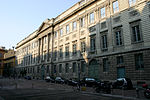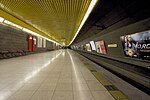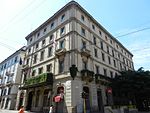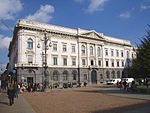Palazzo Gavazzi
Houses completed in 1838Italian palace stubsNeoclassical architecture in MilanPalaces in Milan
Palazzo Gavazzi is a Neoclassical palace in Del Monte district, Milan, Italy. It is typical of the mansions built during the Restoration period, designed by Luigi Clerichetti in 1838 for the wealthy Gavazzi family. Each floor bears its own decorations; Doric columns on the ground floor and various pilasters on the first and second floors, rather than the huge decorative works which were popular at the time. The symmetrical facade, covering three levels, is centred on a portal with four Ionic half-columns supporting the first-floor balcony. The residence was the home of Carlo Cattaneo from 1840 to 1848.
Excerpt from the Wikipedia article Palazzo Gavazzi (License: CC BY-SA 3.0, Authors).Palazzo Gavazzi
Via Alessandro Manzoni, Milan Municipio 1
Geographical coordinates (GPS) Address Website Nearby Places Show on map
Geographical coordinates (GPS)
| Latitude | Longitude |
|---|---|
| N 45.4688 ° | E 9.1919 ° |
Address
Don Lisander
Via Alessandro Manzoni 12/a
20121 Milan, Municipio 1
Lombardy, Italy
Open on Google Maps











